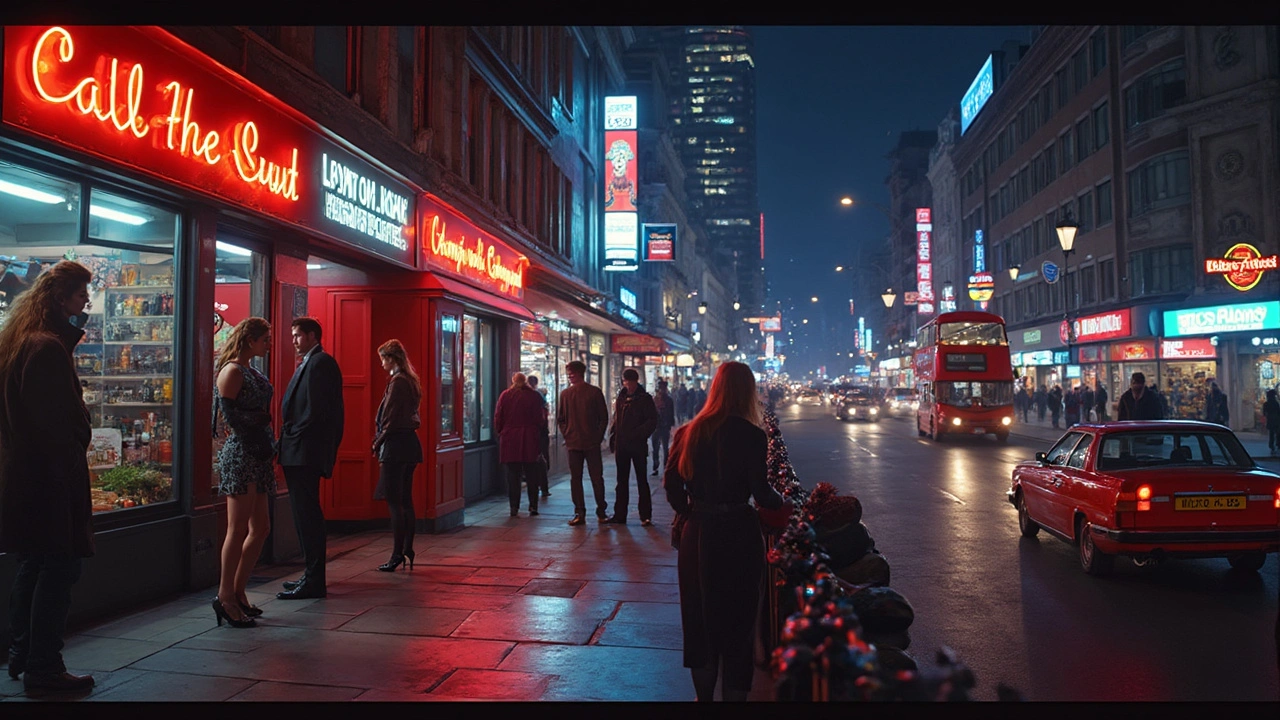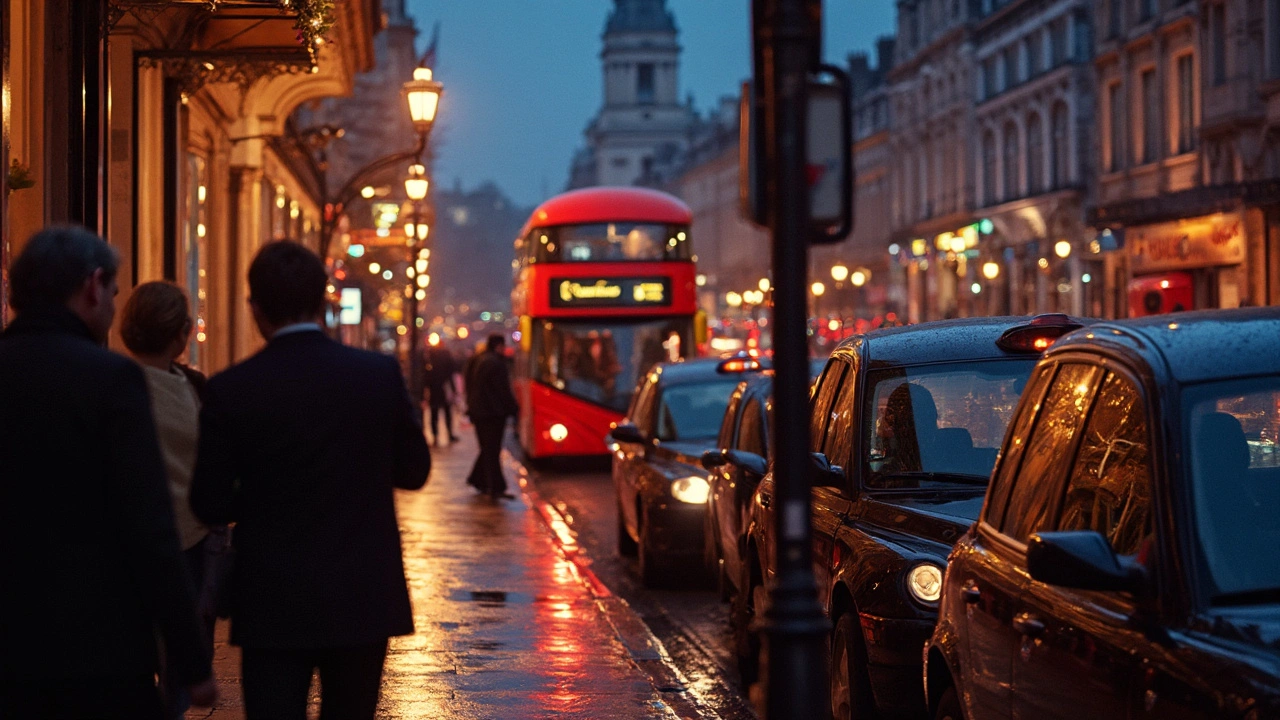The 1980s in London was a melting pot of cultures, styles, and mindsets. It wasn't just about punk rock and Margaret Thatcher; there was a whole other world buzzing beneath the surface — the call girl scene. London call girls in this era, much like today, offered companionship in exchange for a fee, but there was something distinctively electric about the 1980s. The backdrop of neon lights, ritzy clubs, and a more discreet approach to such affairs colored this part of the nightlife.
The life of a call girl in the 1980s wasn't just about glamorous evenings. Many women took on this work for various reasons — from funding a lavish lifestyle to supporting their families. The anonymity that London offered was a big draw, as it allowed for a double life with relative ease. It's fascinating to consider how these women navigated such a complex society, balancing personal desires with financial necessities.
- The 1980s London Scene
- Life of a Call Girl
- Fashion and Lifestyle
- Economic Impact
- Legal Landscape
- Changing Perceptions
The 1980s London Scene
Picture London in the 1980s: it was a city bursting with energy, where new wave music blared from clubs and fashion was as dynamic as the cityscape. It was a decade defined by its counterculture movements, with places like Soho and Mayfair serving as the vibrant centerpieces.
During this time, the nightlife in London was booming. From the glitzy discos to the underground punk clubs, there was something for everyone. These vibrant settings weren’t only about lights and music; they also shaped the environment for the call girl industry, which thrived amid the city's evening buzz.
The Club Scene
The club scene was more than just a party; it was an economic engine. Major nightclubs like The Blitz and Heaven were not only popular dancing spots but also hubs where many transactions happened discreetly. The opulence and anonymity of these venues made them perfect for London call girls to meet clients.
In fact, some of these venues are said to have indirectly supported the escort culture, putting London on the map as a nightlife destination. Club owners, knowingly or unknowingly, contributed to this dynamic with their door policies that encouraged eclectic gatherings.
Cultural Shifts and Influences
Economic factors played a role too. The '80s saw deregulation and the 'Big Bang' in 1986, which transformed London's economy, increasing the wealth disparity. This shift meant more affluent clients were part of the mix, seeking discreet arrangements with call girls.
The media also played its part, with films and TV shows often glamorizing this lifestyle. The portrayal of these worlds made them more mainstream and, to some extent, accepted. Society's changing attitudes contributed to a thriving underground scene, despite the obvious stigmas.
While this paints only part of the picture, understanding the 1980s London scene is crucial for grasping why the call girl industry flourished as it did. The blending of cultural revolution, economic change, and nightlife set the stage for an era that remains fascinating to this day.
Life of a Call Girl
The life of a London call girl in the 1980s was as much about adaptation as it was about glamour. These women often juggled multiple identities, maintaining a façade during the day and embracing their nighttime personas once the sun set. Their stories are as diverse as they come — some stepped into the role seeking financial security, while others were drawn to the excitement and autonomy it offered.
A distinctive aspect of the 1980s was the escort industry's blurred lines with fashion and social trends. Call girls were not just companions; they were influencers of style and culture. High fashion lines often took cues from their bold, glamorous outfits, reflecting the dynamic nightlife. With iconic venues like Stringfellows and The Blitz Club as popular haunts, these women epitomized the era's fusion of style and substance.
Challenges Behind the Glamour
Despite the apparent allure, being a call girl wasn't without its challenges. Safety was a priority, often requiring discrete measures to protect their identities and well-being. They developed networks and relied on each other for support and information, sharing tips to avoid dangerous situations.
Financial Freedom and Independence
The role provided an avenue to financial independence that was otherwise hard to achieve in a male-dominated world. Many call girls managed to earn enough to lead comfortable lives, investing in future ventures or supporting loved ones. Despite societal judgments, the economic freedom offered a sense of empowerment that went beyond the paycheck.
| Year | Estimated Earnings (per night) |
|---|---|
| 1980 | £200-£500 |
| 1985 | £300-£700 |
| 1989 | £400-£900 |
The demand for London call girls in the 1980s was not just about their physical presence but also the ability to adapt to sophisticated social situations, maintaining poise and charm. This highlighted the skill set beyond what was traditionally acknowledged, adding a layer of respect to their public personas.
Fashion and Lifestyle
When you think of the 1980s in London, vibrant fashion and distinctive styles come to mind, and this was no different for London call girls. Their fashion choices were influenced by the pop culture of the time, which embraced bold colors, big hair, and striking makeup. This was a decade where individualism in style thrived.
Walking down the neon-lit streets, you might have noticed call girls donning daring outfits that combined glam and practicality. High heels and statement jewelry were common, creating a blend of sophistication and allure. Bright clothing and bold patterns were not uncommon, reflecting the era's vibrant spirit. This wasn't just about looking the part; it was a strategic presentation that turned heads and attracted clientele.
Wardrobe Staples
Most call girls' wardrobes included a few staples that defined their look:
- Slinky dresses that were both revealing and elegant.
- Leather jackets, adding an edge and a nod to the punk influence.
- Lingerie as outerwear, a trend popularized during this time, offered a tantalizing glimpse beneath the surface.
Fashion was just one side of the lifestyle coin. Many London call girls lived a dual existence, often balancing day jobs or other commitments. Their nightlife pursuits demanded a certain lifestyle that was glamorous yet discreet. It wasn't all parties and nightlife; managing relationships and maintaining boundaries were parts of the gig that required finesse.
Social Impacts
London call girls of the 1980s were not just style icons; they were part of the city's social fabric. The money they earned didn't just support their personal lives — it contributed to the burgeoning economy of London's nightlife. Clubs, bars, and restaurants thrived as a result of their presence, creating an ecosystem that was both financially motivating and socially interconnected.
As much as their fashion and social interaction were on public display, much about their personal lives remained shrouded in mystery, hinting at the fascinating and complex mix of glamour and real-life challenges.

Economic Impact
The economic influence of London call girls during the 1980s was more significant than many realized. It wasn't just about individual earnings; the profession contributed to various sectors of London's economy, directly and indirectly.
Direct Financial Contributions
Call girls catered to a wide spectrum of clients, ranging from local businessmen to international tourists. These clients invested heavily in the city's entertainment industry, spending in hotels, restaurants, and nightclubs. The presence of high-profile escort services often elevated the city's status, attracting wealthy visitors willing to spend lavish amounts, enriching local businesses beyond the escort economy itself.
Supporting Industries
The call girl industry wasn't operating in isolation. It actively supported other sectors. For instance, fashion and beauty industries thrived on the demands of call girls who required clothing, makeup, and accessories. Similarly, transportation services saw a boost as call girls and their clients navigated the city's vibrant nightlife. These cascading economic benefits illustrate how interconnected industries were with the escort history of the era.
The Economic Ripple Effect
There's no denying the ripple effect. The money circulating from this aspect of the nightlife often trickled down to other areas, like real estate, where residential and business properties hosted many clandestine meetings. Although hard to quantify, estimates suggest a considerable contribution to London's informal economy during this period due to such underground activities.
Overall, while often shrouded in secrecy, the economic impact of the London call girl scene in the 1980s was far-reaching, affecting not just the individuals directly involved but also shaping a chunk of the city's economic landscape. Understanding this complex interplay offers insights into how some segments of the informal economy functioned during that vibrant decade.
Legal Landscape
The 1980s London was a time when the legal landscape for call girls was more of a gray area than clear black and white. Technically, prostitution itself wasn't illegal, but many of the related activities were. This made life for a London call girl a bit like walking a legal tightrope.
What Wasn't Allowed?
Activities like pimping, running a brothel, or street solicitation were strictly off-limits. So, many call girls in the 1980s had to find creative ways to connect with clients. Discretion was the name of the game. Many operated through clandestine networks or were set up through agencies that worked under the radar.
Changing Rules
During this decade, there was a gradual shift toward more enforcement and regulation. While the laws themselves didn't change drastically, the police focused more on public order. They often targeted street-walking, which pushed more of the business indoors or through phone connections, which is where the term "call girl" really took off.
This shift wasn't just due to laws but also a changing public perception. People were beginning to see benefits in regulating rather than outright banning. This light at the end of the tunnel for more liberal views hints at today's more structured landscape in the industry.
| Activity | Legal Status in 1980s |
|---|---|
| Prostitution | Legal |
| Operating a Brothel | Illegal |
| Street Soliciting | Illegal |
Seems like navigating legal issues was part of the job for a 1980s London call girl, but it also pushed the industry towards more creative and discreet operations. That's what really set the era apart—a balance between doing business and staying under the radar.
Changing Perceptions
Back in the 1980s, the idea of London call girls carried a lot of stigma. The job was often seen as scandalous, and people generally viewed it with judgment. But things began to shift as the decade wore on. Society's view of sex work started to evolve slowly, and what was once whispered about in shadows became more openly discussed.
Media and Culture
The media played a big role in how perceptions changed. Movies and TV series began to depict call girls in a more nuanced way, uncovering the layers of their lives and showing them as real people with complex stories. London's vibrant arts scene also started to reflect these changes, creating a conversation around the profession that was absent before.Legal and Economic Influences
During this time, some discussions also centered around economic independence. More women entering the workforce across various sectors meant a greater dialogue about rights, autonomy, and respect. In fact, studies conducted in the late 1980s showed a gradual increase in public support for decriminalizing sex work, linking it to issues of personal freedom and economic agency.Statistics of the Time
By the end of the 1980s, research indicated that a growing number of people viewed sex work as a personal choice rather than moral failing. While it didn't erase the stigma entirely, these changing perceptions laid the foundation for future discussions and reform.But old stereotypes die hard, and many myths persisted. The road to acceptance was and still is rocky. However, the gradual shift in attitudes during the 1980s played a vital role in the ongoing journey toward a more comprehensive understanding of sex work.


